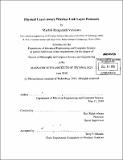| dc.contributor.advisor | Hari Balakrishnan. | en_US |
| dc.contributor.author | Vutukuru, Mythili | en_US |
| dc.contributor.other | Massachusetts Institute of Technology. Dept. of Electrical Engineering and Computer Science. | en_US |
| dc.date.accessioned | 2011-01-26T14:29:18Z | |
| dc.date.available | 2011-01-26T14:29:18Z | |
| dc.date.copyright | 2010 | en_US |
| dc.date.issued | 2010 | en_US |
| dc.identifier.uri | http://hdl.handle.net/1721.1/60816 | |
| dc.description | Thesis (Ph. D.)--Massachusetts Institute of Technology, Dept. of Electrical Engineering and Computer Science, 2010. | en_US |
| dc.description | Cataloged from PDF version of thesis. | en_US |
| dc.description | Includes bibliographical references (p. 129-134). | en_US |
| dc.description.abstract | With wireless devices becoming ubiquitous, the problem of designing high performance and reliable wireless networks is of great importance today. Wireless links are characterized by a rapidly varying channel, requiring transmitters to dynamically adapt their transmit bit rate. The broadcast nature of radio also necessitates the use of medium access protocols to arbitrate access among competing transmitters and reduce losses due to interference, while enabling successful concurrent transmissions. We observe that the problems with existing bit rate adaptation and medium access protocols stem from insufficient information about the wireless channel at the link layer. This dissertation makes two contributions: (i) a redesign of the interface between the physical and link layers in wireless networks to expose more information about the wireless channel to the link layer, and (ii) the design and evaluation of new link-layer protocols that improve throughput by using information about the channel delivered via the new interface. In today's network architecture, the physical layer (PHY) delivers received frames and per-frame signal strength measurements to the link layer. This dissertation proposes two enhancements to this interface: the PHY streams bits to the link layer as soon as they are decoded and before the entire frame reception completes, and it computes and exports SoftPHY hints with each decoded bit. The SoftPHY hint of a bit indicates the PHY's confidence that the decoded bit is correct. We show that the SoftPHY hints of a received frame can be used to estimate the bit error rate (BER) of the wireless channel faster and with more accuracy than with existing methods. We develop the SoftRate bit rate adaptation protocol that uses this BER computed from SoftPHY hints to pick transmit bit rates and improves throughput by 2 x over existing protocols. The streaming PHY interface enables the link layer to learn about the current transmission on the air by decoding headers before frame reception completes. The SoftCMAP and CMAP protocols make smart medium access decisions using this knowledge of ongoing transmissions along with a distributed map of conflicting transmissions, and improve aggregate network throughput by up to 50% by increasing the number of successful concurrent transmissions. | en_US |
| dc.description.statementofresponsibility | by Mythili Ranganath Vutukuru. | en_US |
| dc.format.extent | 134 p. | en_US |
| dc.language.iso | eng | en_US |
| dc.publisher | Massachusetts Institute of Technology | en_US |
| dc.rights | M.I.T. theses are protected by
copyright. They may be viewed from this source for any purpose, but
reproduction or distribution in any format is prohibited without written
permission. See provided URL for inquiries about permission. | en_US |
| dc.rights.uri | http://dspace.mit.edu/handle/1721.1/7582 | en_US |
| dc.subject | Electrical Engineering and Computer Science. | en_US |
| dc.title | Physical layer-aware wireless link layer protocols | en_US |
| dc.title.alternative | PHY-aware wireless link layer protocols | en_US |
| dc.type | Thesis | en_US |
| dc.description.degree | Ph.D. | en_US |
| dc.contributor.department | Massachusetts Institute of Technology. Department of Electrical Engineering and Computer Science | |
| dc.identifier.oclc | 696795985 | en_US |
